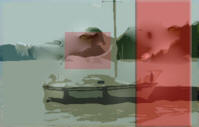|
1.
Choose a spot where you wish to anchor.
2. Determine the
greatest area of swing your boat will cover if anchored in the area.
3. Motor 360
degrees around the swing area to check the water depths.
4. Determine the
method of anchoring you will use. The first boat in an anchorage
usually determines the anchoring method, and the other boats should
follow suit unless the first boat has chosen a totally inappropriate
method.
5. Be aware that
larger, heavier boats do not respond to wind shifts as quickly as
smaller, lighter boats, so pay attention to your neighbors and allow
them sufficient swing room. Also be aware that boats tend to drift
in haphazard directions when the wind dies completely.
6. Approach your
anchoring spot from a down wind position. Motor slowly upwind, and
allow the wind to slow and stop the boat.
7. When the
forward motion of the boat has stopped, release the anchor while
maintaining control over the amount of chain and/or rode that is let
out. Do not allow all the chain/rode to form a pile on top of the
anchor.
8. Pay out sufficient
chain/rode to match the motion of the boat as the wind pushes it
backwards. Do not allow the chain/rode to become too taut, and do
not motor backwards. Be patient and allow the wind to push the
boat.
9. The wind will
tend to move the bow faster than the stern, and the boat may try to turn
sideways. Use tension on the chain/rode to straighten the boat and
keep the boat straight and pointing into the wind.
10. When you
have about a 3:1 ratio of rode to water depth, cleat the chain/rode and
give the anchor a slight tug by reversing power on the boat. This
will cause the anchor to bite into the bottom.
11. Uncleat the
chain/rode and allow the wind to push the boat back farther as you let
out more chain/rode.
12. When
sufficient chain/rode has been let out--usually a 7:1 ratio for
overnight and 5:1 ratio for a temporary stay--cleat the chain/rode, and
motor in reverse to set the anchor. Start with 1000 rpm and
increase slowly to 2000 rpm. (1000 rpm will hold a boat in 20 knot
winds; 1500 rpm in 30 knot winds; and 2000 rpm in 40 knot winds.)
13. Find two aligned
objects on the shore and watch them while motoring in reverse. If
the anchor is set and the boat is not moving, the objects should remain
in alignment. If the objects move apart, the anchor is
dragging. You can also feel the anchor dragging by placing your
foot on the chain/rode near the windlass and feel it bouncing or jumping
as the anchor is dragged over the sea bottom.
14. If the
anchor drags, you can try to let out more chain/rode and then repeat
steps 12 and 13. If the anchor still drags, you will have to raise
it and start the anchoring process over again. If the water is
clear and warm, you can swim out and see what the problem is. (I
always like to swim out and look at the anchor before I determine that
it is set properly regardless of whether or not I've encountered a
problem anchoring.) To be properly set, the anchor must have its
flukes dug into the bottom. If it is lying on its side, pull it up
and re-anchor.
15. If you have
determined that the anchor is set, cleat the chain/rode and attach a
snubber line to take the strain and pressure off the windlass.
16. It is also a
good idea to set an anchor watch for the first hour, but not many
recreational sailors do this. To carry out an anchor watch, you
would use a handbearing compass to site and record bearings of various
objects on shore. (Preferably the objects should be located
between 10 to 2 o'clock or 4 to 8 o'clock using the bow of the boat as
12 o'clock.) Then during the hour, you would take additional
bearings of the same objects. Although the bearings would change
because the boat would swing slightly at anchor, the number of degrees
between the objects would remain constant if the boat is not moving
backwards. If the number of degrees between the objects changes
drastically, there is a good chance the anchor is dragging and you would
need to re-anchor. |


![]()